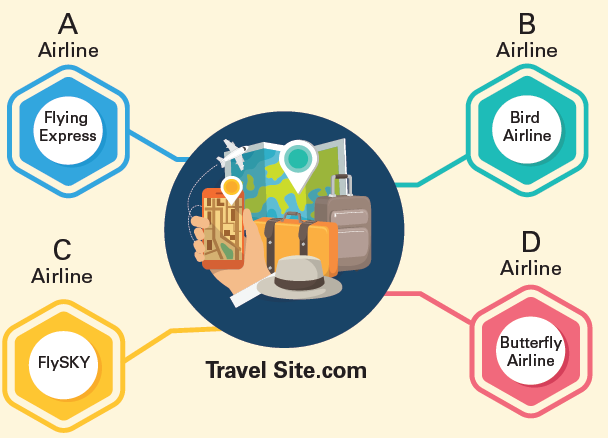APIs MuleSoft Strategy | Application programming interfaces explained
(Application Programming Interface) API is the acronym for Application Programming Interface, which is a software intermediary that allows two applications to talk to each other. Each time you use an app like Facebook, send an instant message, or check the weather on your phone, you're using an API.
Application Program Interface
APIs are a set of functions and procedures that allow for the creation of applications that access data and features of other applications, services or operating system.
According to Wikipedia, good APIs makes it easier to develop a computer program by providing all the building blocks, which are then put together by the programmer.”

So, what exactly is an API?
An application program interface (API) is a toolset that programmers can use to help them create software. To put it simply, an API specifies how software components should interact.
To describe the concept in further detail, you need to comprehend the basics. Let’s start with my favorite analogy of a restaurant menu. When you go to a restaurant to eat, you choose from the selection on the menu. From this point, you convey your choices to the waiter. He/she then takes your choices to the chef, they prepare your meal and it’s returned to you for a nice meal. From this point, you may ask yourself, do you know what the chef used in your fish or steak? How was it prepared? This back and forth analogy serves as a starting point for this explanation.
Why? Because with an API, you really don’t know what’s going on behind the scenes at the restaurant. All you really know is that you gave your food order, it was processed and out came your dinner on a nice plate.
A real-world example
A real-world example is buying movie tickets online. You go to the movie site, you enter your movie, name and credit card information, and lo and behold, you print out your tickets. But what’s going on between entering your information to receiving your ticket? APIs, that’s what!
They are collaborating behind the scenes with other applications. How is this possible you ask? This type of integration is called “seamless” because you never have a clue when a software role is passed from one application to another.
Different Types of APIs
Did you know that there isn’t just one type of API? There are three main types of APIs and they are used by groups for specific types of apps.
Now that you know more about APIs, their functions, and the different types, the next set is learning about API Management and how it can help your business.
The key components of an API strategy
MuleSoft is the only company that offers a unified solution for composition, API management, and connectivity. Anypoint Platform, MuleSoft’s flagship product, has all the pieces of the enterprise agility puzzle. Get started on defining, creating, and maintaining your organization’s API strategy:
Designing and building modern APIs
The modern API, also known as the API building block, consists of functionality and simplicity required for the full lifecycle of APIs, connectivity to any source of data, ability to compose the data, and provides full visibility, security, governance right from design. You can’t execute on an effective API strategy without having well-designed APIs

What is an API?
What is API Management?
What is Custom Code?
Type of APIs
How to Design and Manage APIs
What is REST API Design?
API Development Best Practices
A Guide to Designing the Perfect API
The Importance of API Documentation
Secrets of a Great API
API-First Development with RAML and SoapUI
The API Love Triangle: Delivering Successful API Programs
API Security by Design
Managing APIs throughout their full lifecycle
The modern API is a product and it has its own software development lifecycle (SDLC) consisting of design, test, build, management, and versioning. It also comes with thorough documentation to enable its consumption.
Managing APIs throughout their entire lifecycle is critical to achieving an API strategy’s power to affect digital transformation.
Gartner’s Magic Quadrant for Full Lifecycle API Management,
Managing the Full API Lifecycle
API Management for Product Managers
7 Habits of Effective API and Service Management
Developing your organization’s API strategy
Building great APIs must go hand-in-hand with using them to develop our recommended API strategy, API-led connectivity. Here’s how to get started:
API-led Connectivity: The Next Step in the Evolution of SOA
So You Want to Develop an API Strategy. Now What?
Best Practices for Microservices
What is Agile Project Development?
The Application Network
Benefits of having a well-defined API strategy
When our customers adopt an API strategy, they experience dramatic and positive business outcomes. Here are real-world case studies of how our customers achieved digital transformation with our recommended API strategy.
API strategy essentials: a practical guide to winning in the API economy
What is an API Economy
The Rising Value of APIs
How Our Customers Get it Done Faster
Case Study: Cox Automotive
Case Study: Dixons Carphone
Operate and exploit advertising by iCOMM Vietnam Media and Technology Joint Stock Company.
Adress: 99 Nguyen Tat Thanh, To 2, Khu 6, Thi tran Tan Phu, Tan Phu, Dong Nai.
Email: phuongtran2191@gmail.com | Tel: (+84) 984654960
Editor in chief: Tran Nha Phuong
Company: Lucie Guillot (Nha Phuong Tran)




